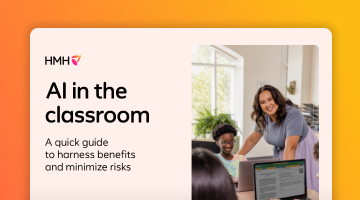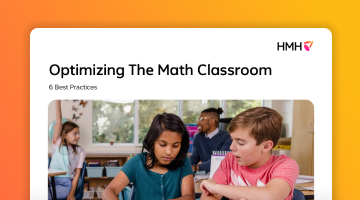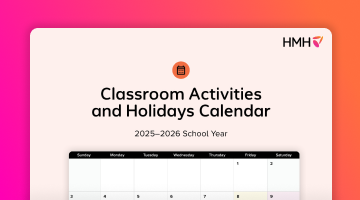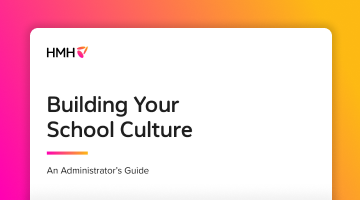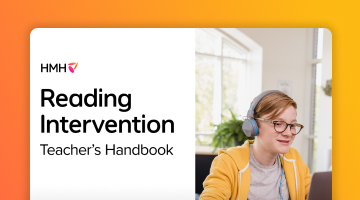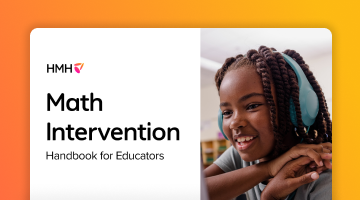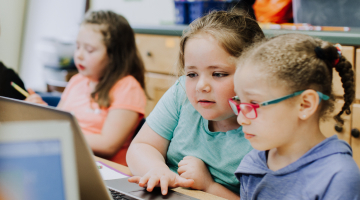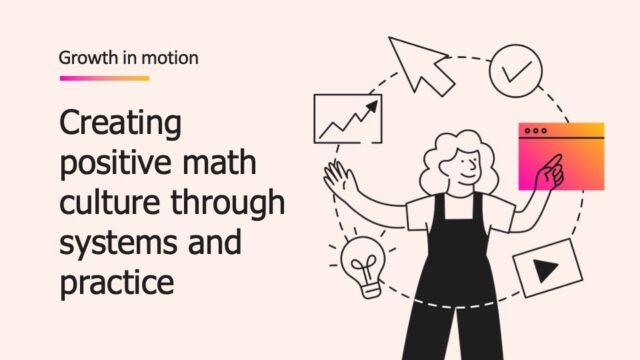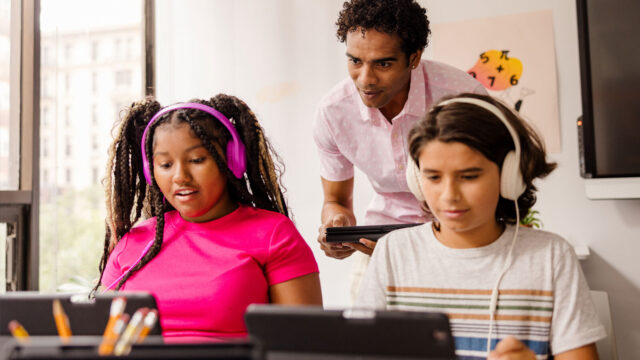
I am passionate about helping teachers succeed. I understand how complex their profession is, and I am proud to work at an organization that puts teachers first. In my role, I work closely with instructional coaches who work shoulder to shoulder with teachers and education leaders and are committed to their success.
Student outcomes are what everyone is striving for, and it is the teachers at the frontlines who are working to achieve them. Achieving student outcomes involves careful planning, honing a variety of skills, collaborating with the larger community, and looking critically at data. It is a problem that no teacher needs to solve alone, with professional learning being one powerful part of the solution.
Professional learning definition
Professional learning, or PL, is a process for teachers to improve their practice of teaching. It aims to help teachers build confidence and improve student outcomes. It’s more than just skill development; it’s about active learning that can be applied right away in the classroom. PL is not a one-off experience. Rather, a professional learning definition should include an ongoing process that allows for practice and feedback to keep teachers’ learning effective and relevant.
What is professional learning for teachers?
When teachers undergo this process of practicing skills and receiving process, they are receiving professional learning. When it is done well, it can be so valuable. Teachers are engaged and learning new skills that help them in their jobs. High-quality professional learning is actionable and relevant. It gets teachers and leaders sharing their knowledge with others, creating a ripple effect throughout the school.
Professional learning can come from different sources, like an instructional coach within the building or an external partner. Yet many educators have felt frustrated by their PL experiences, often with good reason. Not all providers deliver effective training, and teachers are sometimes not recognized as seasoned professionals. As a result, some teachers might feel skeptical or resistant to PL. Effective PL esteems and engages teachers. It builds upon current skills, like deepening teachers’ knowledge on structured literacy or improving student writing skills through collaborative analysis.
The difference between professional development vs. professional learning
While “professional development” and “professional learning” are often used interchangeably, at least at HMH, we think of these differently. Professional development, or PD, is thought of as a one-and-done training. Often it looks like this: a facilitator comes in, delivers content, then leaves. This isn’t always bad; educators can learn from the facilitator, and plenty of facilitators excel at this type of work. But the importance of professional development for teachers might stop there when there isn’t follow-up of someone checking against desired outcomes and making sure the training works in a teacher’s specific classroom.
Professional learning, on the other hand, expands on that. It is meaningful, active, and engaging. It is an approach that defines outcomes and fosters relationships among teachers and support coaches. Achieving student outcomes requires nurturing learners’ natural curiosity and keeping them engaged. Professional learning for teachers should be no different. All of us—children and adults alike—learn best when we’re invested and engaged.
When contrasting professional development vs. professional learning, having a professional learning coach is often an important difference. An effective coach is always curious, working to figure out what will be successful in a teacher’s classroom. Ideas should be tested. Challenges and failures should be allowed as learning opportunities. For PL to have impact, there must be trust between the teachers and the coaches, who are themselves passionate educators. Evidence supports the impact of this kind of individualized coaching. “Across all coaching models, we estimate that coaching raised student performance,” according to one influential meta-analysis.
The benefits of teacher professional learning
On the most practical level, professional learning saves teachers time. When teachers invest in learning their profession more deeply, they become more efficient in their work. Instead of spending hours searching for resources or figuring out lesson plans on their own, they know more quickly what they need and where to find it.
Professional learning can also reignite a teacher’s passion for their work. Teaching today is as challenging as ever, and it’s easy for teachers to lose sight of the impact they have on students. A professional learning coach has the potential to help teachers remember why they chose this profession in the first place. The best PL adapts to precisely what each teacher needs, even if it has nothing to do with the subject matter! If teachers are struggling with basic resources like access to school supplies or a physical space conducive to learning, an effective coach can provide support and help them navigate those challenges.
All said, the benefits of PL go deeper than test scores and standards. Effective teacher professional learning introduces new ideas, leads to new perspectives, and is designed to keep teachers engaged. Research shows that when teachers are committed to the coaching process, they achieve better results. It’s a positive feedback loop; as teachers become better at their craft, they want to learn more. “Teachers’ self-efficacy in teaching is positively related to their autonomous motivation for learning,” write Zhang et al. in a 2021 study on continuous professional learning. “This means that the higher teachers’ confidence in teaching, the more motivated they are to participate in professional learning.”
Having a plan
Growing as a teacher can focus on technical skills like learning new technology or pedagogical techniques. Or it can focus on “soft” skills like self-awareness or building student engagement. There are varying levels of hands-on and hands-off approaches, all depending on what’s available and appropriate. With so many ways to approach growth as a teacher, it’s important to plan professional learning collaboratively.
What are professional learning goals?
Teachers will always have annual goals and aspirations. The challenge is to translate these into concrete professional learning goals, which depend on requirements set by their individual district and school. These may include objectives like a focus on literacy or college and career readiness, which can then be broken down into what’s achievable for the classroom and matches curriculum objectives.
The most effective goals are aligned across district, school, grade, and classroom levels. When writing each goal, start with the student in mind and work backwards. Focus on student outcomes, and then identify 1–3 key objectives that will move the needle. Teachers should also consider both immediate and long-term career development. They are improving outcomes for their current students while also building professional skills for their futures.
What is a professional learning plan?
Once goals are established, the next step is to develop a professional learning plan that strategizes how to achieve those goals. A professional learning plan can be for an individual teacher, or it can apply to all teachers in a school or district. In that case it is sometimes also called an implementation plan and includes specific, measurable goals, like “use particular educational software three times per day for 20 minutes per session.”
It may help to think of a plan as a cycle. Ideally, teachers have access to coaches and form healthy one-to-one relationships with them. The coaches then check in every week to see what teachers want to work on next. The plan is necessarily flexible and adjusts to circumstances such as the teacher’s experience and whether observations are happening.
Having a community
Educators can’t do it alone. It’s a fundamentally social profession. Teachers are with students, colleagues, and community members a lot of the time. Teachers operate at grade-level and department-level cohorts, where they can work as a team grappling with similar problems and growing with each other professionally.
Teachers are some of the most passionate humans I know. I’m in constant awe of the generosity and support I see them offer one another in our Teacher’s Corner Facebook group, for instance. They want to share resources and offer ideas. When outside of work, they want to talk about it. They’re excited about it. Teaching is a profession of learning, after all, and its practitioners never stop wanting to learn.
What is a professional learning community in education?
A professional learning community, or PLC, is an organized group of educators who meet regularly to share expertise, review student work, plan instruction, and collaborate towards achieving educational goals. The educators may come together across grade or department levels, and importantly, they are often looking at data. This is how to ensure that teachers are working to move the needle in achieving student outcomes.
There is always an objective to a PLC meeting. For example, one might be organized around reviewing second grade data with the objective of using it to strategically plan the next three weeks. In a healthy PLC, educators work together towards a common goal, reviewing each other’s scores, executing on plans, then following up to see how they did and tweak those plans for the future.
Coaches can collaborate with and support PLCs. They can help to review lessons or assessment data or differentiate instruction for an upcoming lesson. Coaches can help with a wide range of questions: What tiers are students in? Which students need more instruction? What does “more” look like for them?
Professional learning opportunities for teachers
HMH offers coaching and other professional learning options. But there are many ways for teachers to seek out and take advantage of professional learning that works for them. Here are some resources to consider:
- Model Schools Conference
- Professional organization conferences, such as those for ISTE, NAEYC, or NCTM, along with the digital and printed materials those organizations produce
- Podcasts (such as Teachers in America)
- Teacher’s Corner on Ed
- Teacher’s Corner Facebook group
- HMH Coachly
- Your PLC
- HMH’s blog and YouTube channel
Ultimately, investing in professional learning is an investment in yourself. Finding success as a teacher means needing to be all in. The profession is a calling for so many; you know when you belong. You may not feel like you have anything mastered, but you don’t have to master it. Ask questions, be curious, and know that so long you’re teaching, you’re making a difference.
***
For access to ongoing coaching and on-demand resources, HMH offers nationally recognized professional learning and professional development for teachers, along with professional development courses for teachers.
Get the eBook Building Your School Culture: An Administrator’s Guide today!

